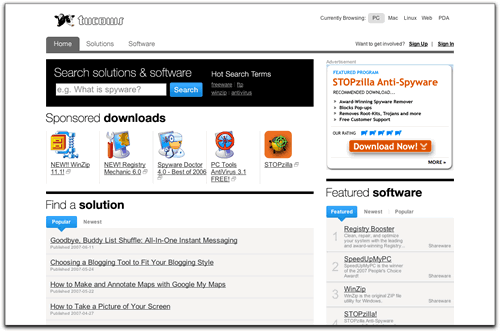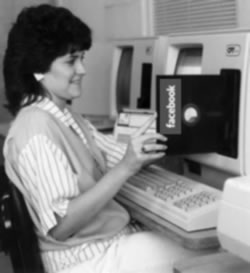The obligatory disclaimer: Yes, I work for Tucows, where I hold the title of Technical Evangelist.
From Shareware to Solutions
The Tucows site — that is the one at tucows.com, the original site where the company got its start as being a place to download shareware — has undergone a big makeover. Here’s a screenshot:

Click the screenshot to visit Tucows.com.
 Back when the company got started in the early 90s, finding software online was difficult. Search engines were just in their infancy, 28.8 kbps modems were considered fast and it actually made sense to publish magazines and even books simply cataloging sites and software that you could find online. During this era, Tucows and a number companies found a niche as places where you could find and download software as well as see reviews.
Back when the company got started in the early 90s, finding software online was difficult. Search engines were just in their infancy, 28.8 kbps modems were considered fast and it actually made sense to publish magazines and even books simply cataloging sites and software that you could find online. During this era, Tucows and a number companies found a niche as places where you could find and download software as well as see reviews.
In the age of high-speed connections, Google search, AdSense and that amorphous thing called Web 2.0, the “shareware site” approach doesn’t make as much sense. I download many of my applications directly from the vendor, and number of other apps I use exist as web applications.
In spite of the technological changes since Tucows’ early days — when processor power was measured double-digit megahertz and there was less RAM in my machine than in my present-day key fob — one thing remains: people are still asking “How can I do this using my computer?”
The new Tucows site aims to be a place online where you can go to find solutions to your computer and internet questions and problems. By “solution”, we mean anything that solves your problem. Sometimes it’s software that you can download. Sometimes it’s a web application or site. Sometimes it’s a set of steps that you can follow.No matter what the solution may be, we want to be the place where you can find it.
A Quick Tour
If you visit Tucows.com, the first thing you’ll see, right near the top of the page is the Search solutions & software box, where you can start your search quickly.

Click the screenshot to visit Tucows.com.
If you’re not sure of what to search for or prefer browsing through solutions, there’s a list of popular and recent solutions just below the search box:

Click the screenshot to visit Tucows.com.
Clicking on a solution title takes you to the page for the solution, which may provide download links, links to site or an article, depending on the solution:

Click the screenshot to visit Tucows.com.
You don’t need to sign up for an account, but if you do, you can also rate and comment on solutions:

Click the screenshot to visit Tucows.com.
With an account, not only can you offer your feedback on an existing solution, you can also submit your own.
Give the new Tucows.com a try!
For More…
- Tucows Gets Social, the Original Software Download Site, Launches Radical Redesign: the official announcement of the site’s re-vamp.
- A screencast featuring the new site, featuring me and Greg Weir, our Director of Content Services. [Length: 8 minutes, 10 seconds]

 See the guy on the right? That’s Mainframe, the computer specialist for the good guys in the animated TV series G.I. Joe. In case you’re not familiar with the character, you might want to consult
See the guy on the right? That’s Mainframe, the computer specialist for the good guys in the animated TV series G.I. Joe. In case you’re not familiar with the character, you might want to consult 




